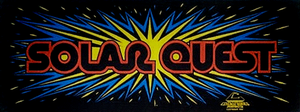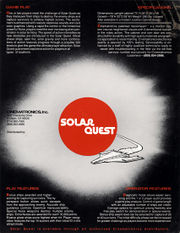Lost In Translation/Solar Quest
| Solar Quest | |
|---|---|
| Manufacturer | Cinematronics |
| Released | 1981 |
| Control Method |
2-way Joystick 4 Button(s) |
| Main CPU | CCPU (@ 5.000 MHz) |
| Sound CPU | Mono Discrete |
| Video Details |
Vector (Horizontal) 0 x 0 pixels 38.00 Hz 32,768 Palette colours |
| Screens | 1 |
| ROM Info | 10 ROMs 16,800 bytes (16.41 KiB) |
| MAME ID | solarq |
About The Game
Solar Quest is an arcade video game.
In the centre of the screen is a sun. Any space ships or ship's fire coming in contact with the sun are destroyed. The sun exerts an increasing gravitational pull as play progresses.
A player controlled space ship is randomly located on the screen. The space ship's movement is controlled by rotate right, rotate left, and thrust buttons. For quick escapes, the space ship can be thrust into hyperspace, causing the ship to disappear and then reappear in a different location.
The space ship possesses two weapons. The first weapon consists of shots fired by pressing the fire button. These shots will destroy any alien ships they strike, but will disintegrate if they do not hit any targets. The second weapon is a nuke which is launched by pressing the nuke button. The nuke will continue to travel across the screen until either it strikes a target or the player detonates the nuke by pressing the nuke button a second time. The nuke will destroy all alien ships within a limited radius of the explosion.
At the top of the screen is a display showing the player's score, the number of ships remaining, and the number of nukes a player has available.
The game consists of different phases. Each phase begins with several alien ships appearing from random points along the edge of the screen. The number of the alien ships is determined by the phase, with a maximum of eight ships for any single type of alien ship in a phase.
The alien ships move across the screen in a random pattern. After a predetermined time, dependent upon the phase, the alien ships will begin to chase the player's space ship. The player must shoot the alien ships before his ship is rammed by an alien ship. In later phases, the alien ships can shoot at the player's space ship as well as ram it.
Any alien ship that is destroyed by the player will leave a survivor. The player can either capture or kill the survivor. Survivors cannot be killed with nukes. If the survivor is neither captured nor killed, it will begin to drift towards the sun. Survivors disappear when they come in contact with the sun.
If the player does not shoot any alien ships, one or two ghost ships will appear and begin to chase the player's space ship. The ghost ship will shoot at the player's space ship during any phase. The length of time it takes for the ghost ships to appear shortens with each phase, until at least one is always present. A ghost ship will not leave a survivor when it is destroyed.
During a phase, seven different types of alien ships will appear. It is possible for several types of alien ships to be on the screen at one time. A phase is completed after all the alien ships have been destroyed or a specific amount of time has elapsed.
A player must be careful when using hyperspace. Excessive use will cause hyperspace to lock-out for a short period, making a player's space ship more vulnerable. A player's space ship cannot be destroyed in hyperspace.
As play continues, each phase becomes successively more difficult; the number of alien ships increases, the length of time before the alien ships attack shortens, and the alien ships firing capability activates. When a player's space ship is destroyed, play resumes at the same point. The game ends when all of a player's space ships are destroyed.
One and two player options are available. In the two player mode, players alternate until all their ships are destroyed. If one player receives more extra ships than another, he will be allowed to play the extra ships even though his opponent's game is over.
An extra nuke is awarded every 10,000 points. An extra space ship is awarded after capturing a specified number of survivors.
Additional Technical Information
Players : 2
Buttons : 4
=> [1] Thrust, [2] Fire, [3] Hyperspace, [4] Nuke
Trivia
This was the last 'Black and white with a colour overlay' vector game produced by Cinematronics. Solar Quest was a last minute game. Cinematronics was heading towards the trade show season with only "Boxing Bugs" to show, which they felt was not a winner. Scott Bodden who had left the company earlier, was called in as a contractor to write Solar Quest. He completed this in a mere 90 days.
A Solar Quest machine was shown at the 2003 classic arcade games show 'California Extreme' in San Jose, California.
Scoring
| Target | Points |
|---|---|
| 1st Alien | 250 |
| 2nd Alien | 300 |
| 3rd Alien | 350 |
| 4th Alien | 400 |
| 5th Alien | 450 |
| 6th Alien | 500 |
| 7th Alien | 750 |
| Ghost | 2,500 |
| Survivor | 250 |
| Survivor Captured | 1,000 |
Tips and tricks
Game Features
- The number of alien ships for any type increases from four in phase one, to eight in phase five.
- The sun's gravity increases with each phase, starting in phase five.
- The speed of the alien ships increases with each phase.
- Alien ships' firing capability becomes activated in phases five through eleven. The seventh type of alien ship receives firing capability in phase five, the sixth type in phase six, the fifth type in phase seven, and so on, until all the, alien ships have firing capability in phase eleven.
- The ghost ships will appear in a shorter amount of time each phase, until at least one is always present.
- The number of captured survivors needed to receive an extra space ship is adjustable, either twenty-five or forty.
- The number of ships per credit is adjustable, either three or five.
- The number of credits per coin is adjustable.
Staff
- Designed & Programmed By
- Scott Boden
Cabinet and Artwork
Ports
- Consoles
- GCE Vectrex (1982)







